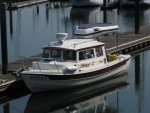BrentB":1pltjeqh said:
I used A1 fuel feed hose. It
has a fire resistant cover; is designed to have fuel in the hose at all times. Least permeable with highest fire resistance.
Good point to mention. A1 rated hose is the correct designation to use for most fuel lines. Fills can be A2 rated (and I believe vents as well, but I'm a bit rusty on that without looking it up). However, within the A1 and A2 designations, there is still a variety of options of specific hose model number. I used all Trident brand hose, but there are other good marine hose manufacturers (Shields, Vetus, etc.). Going by memory (when I chose the various hoses I temporarily immersed myself in their hose catalog, but that's been a couple of years ago now)...
1) Fill hose was Trident #329 (type A2). #329 is a corrugated (Michelin Tire Man look) type hose, which I used because it would made the necessary bends more easily -- without putting excessive pressure on the plastic filler necks of the fuel tanks (especially the port side fill, which doglegs around the lazarette).
2) Vent lines were another Trident hose, but I can't remember which one right now.
3) I then bought some Trident #305 ethanol resistant fuel hose for the outboard supply lines (grey in color; was recommended for outboards), but found it very "thin" and prone to kinking. It just didn't give me a good feeling because of the way the supply lines in the splashwell need to move). So I ended up using another Trident hose (#365, I think, but might have been #319) that was quite a bit thicker, black, and not prone to kinking. I used this for all the supply lines, both from the tanks and in the splashwell.
4) But I did find a good use for the thinner grey #305 hose, which was to replace the main fuel line inside my Yamaha 80 (from where it enters the engine cowling to the internal fuel filter). The thicker hose would never have fit, and kinking wasn't an issue as the line is "guided" over the whole path.
The Trident hose catalog link is here: (2.7MB download):
http://tridentmarine.com/wp-content/upl ... atalog.pdf
